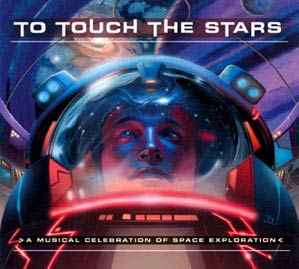Review: To Touch the Starsby Jeff Foust
|
| There’s a mix of approaches represented on the album: inspirational, celebratory, mournful, even humorous, but all focused on space exploration in one way or another. |
In an effort to fill this void comes “To Touch the Stars” ($15.97), a compilation of 17 songs about space exploration released recently by Prometheus Music. The album had its roots in a songwriting competition organized in 1997 by the National Space Society. The top three songs from the one-time Apollo Award, announced at the International Space Development Conference in 1998, are included on the album. Those songs are joined by the winner of the Mars Society’s Rouget de Lisle competition (named after the composer of “The Marseillaise”) in 2000. The common thread to both contests was Robert Zubrin, who explains his reasons for organizing those competitions in an essay included in a full-color booklet in the CD.
I had anticipated an album full of filk, that branch of folk music that has become a staple of science fiction, and some space, conferences. Filk has a fervent, but fairly narrow, fan base: outside of the science fiction community few have heard of it. While most, if not all, of the songs could be comfortably classified as filk, the songs go beyond the stereotype—in mainstream folk music as well as filk—of the lone singer strumming his or her guitar, reciting cleverly rhyming lyrics. There’s a mix of approaches represented here: inspirational, celebratory, mournful, even humorous, but all focused on space exploration in one way or another.
It’s that mix that is the album’s major strength—and weakness. It’s a strength in that with such a mix there’s bound to be at least a track or two that most anyone with an interest in space will enjoy. It’s a weakness, though, because there’s also bound to be a track or two that, for whatever reason, doesn’t resonate with the listener. For example, I enjoyed “I Want to Go to Mars” by The Birdwatchers (featuring filmmaker Sam Burbank on lead vocals), perhaps the closest song on the album to a more conventional pop/rock song, as well as the whimsical “Dance on the Ceiling”. However, other songs, like “Hope Eyrie” and “Star Fire” failed to elicit much of a reaction, and “Legends” was almost too depressing to listen to. However, that success rate is common among all sorts of albums, including both compilations by various artists as well as releases by popular artists who stuff albums with a few hits and a much larger amount of less palatable fare.
While some might hope that “To Touch the Stars” might serve to promote space exploration to a wider community, this seems a bit unlikely: it is, effectively, a folk album, and likely will be consigned to that relatively narrow niche, hidden in the back of the music store and with little radio airplay. (The back of the CD is helpfully labeled “File Under: Folk/Rock”; the former seems a more likely category than the latter.) However, it may be more effective as nourishment for space advocates: even the staunchest supporter of space exploration can use some music to keep themselves inspired. In that role “To Touch the Stars” does a fine job. It has a home on my iPod, alongside a mix of more conventional alternative and classic rock. Including, of course, “Supercollider”…
